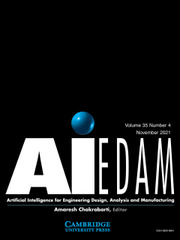Crossref Citations
This article has been cited by the following publications. This list is generated based on data provided by
Crossref.
Chen, Yong
Zhang, Zhinan
Huang, Jian
and
Xie, Youbai
2013.
Toward a scientific ontology based concept of function.
Artificial Intelligence for Engineering Design, Analysis and Manufacturing,
Vol. 27,
Issue. 3,
p.
241.
He, Bin
and
Feng, Peien
2013.
Guiding conceptual design through functional space exploration.
The International Journal of Advanced Manufacturing Technology,
Vol. 66,
Issue. 9-12,
p.
1999.
Stone, Robert B.
Goel, Ashok K.
and
McAdams, Daniel A.
2014.
Biologically Inspired Design.
p.
1.
Nagel, Jacquelyn K. S.
Stone, Robert B.
and
McAdams, Daniel A.
2014.
Biologically Inspired Design.
p.
95.
Nagel, Jacquelyn K. S.
2014.
Biologically Inspired Design.
p.
63.
Hsiao, Shih‐Wen
and
Tsai, Cheng‐Ju
2015.
Transforming the natural colors of an image into product design: A computer‐aided color planning system based on fuzzy pattern recognition.
Color Research & Application,
Vol. 40,
Issue. 6,
p.
612.
Vandevenne, Dennis
Verhaegen, Paul-Armand
Dewulf, Simon
and
Duflou, Joost R.
2015.
A scalable approach for ideation in biologically inspired design.
Artificial Intelligence for Engineering Design, Analysis and Manufacturing,
Vol. 29,
Issue. 1,
p.
19.
Kennedy, Emily Barbara
and
Marting, Thomas Andrew
2016.
Biomimicry: Streamlining the Front End of Innovation for Environmentally Sustainable Products.
Research-Technology Management,
Vol. 59,
Issue. 4,
p.
40.
Vandevenne, Dennis
Verhaegen, Paul-Armand
Dewulf, Simon
and
Duflou, Joost R.
2016.
SEABIRD: Scalable search for systematic biologically inspired design.
Artificial Intelligence for Engineering Design, Analysis and Manufacturing,
Vol. 30,
Issue. 1,
p.
78.
Vandevenne, D.
Pieters, T.
and
Duflou, J.R.
2016.
Enhancing novelty with knowledge-based support for Biologically-Inspired Design.
Design Studies,
Vol. 46,
Issue. ,
p.
152.
Salgueiredo, Camila Freitas
and
Hatchuel, Armand
2016.
Beyond analogy: A model of bioinspiration for creative design.
Artificial Intelligence for Engineering Design, Analysis and Manufacturing,
Vol. 30,
Issue. 2,
p.
159.
Mirtalaie, Monireh Alsadat
Hussain, Omar Khadeer
Chang, Elizabeth
and
Hussain, Farookh Khadeer
2017.
A decision support framework for identifying novel ideas in new product development from cross-domain analysis.
Information Systems,
Vol. 69,
Issue. ,
p.
59.
Goel, Ashok K.
Tuchez, Christian
Hancock, William
and
Frazer, Keith
2017.
Design Computing and Cognition '16.
p.
157.
Sarkar, Biplab
Chakrabarti, Amaresh
and
Ananthasuresh, G. K.
2017.
Synthesis of feedback-based design concepts for sensors.
Research in Engineering Design,
Vol. 28,
Issue. 1,
p.
131.
Wanieck, Kristina
Fayemi, Pierre-Emmanuel
Maranzana, Nicolas
Zollfrank, Cordt
and
Jacobs, Shoshanah
2017.
Biomimetics and its tools.
Bioinspired, Biomimetic and Nanobiomaterials,
Vol. 6,
Issue. 2,
p.
53.
Kennedy, Emily B.
and
Niewiarowski, Peter H.
2018.
Biomimicry: Do Frames of Inquiry Support Search and Identification of Biological Models?.
Designs,
Vol. 2,
Issue. 3,
p.
27.
Kruiper, Ruben
Vincent, Julian F. V.
Abraham, Eitan
Soar, Rupert C.
Konstas, Ioannis
Chen-Burger, Jessica
and
Desmulliez, Marc P. Y.
2018.
Towards a Design Process for Computer-Aided Biomimetics.
Biomimetics,
Vol. 3,
Issue. 3,
p.
14.
Goel, Ashok K.
and
Hancock, William
2021.
Multifunctional and domain independent? A meta-analysis of case studies of biologically inspired design.
Design Science,
Vol. 7,
Issue. ,
Zhang, Zijian
and
Jin, Yan
2022.
Exploring Visual Cues for Design Analogy: A Deep Learning Approach.
Journal of Mechanical Design,
Vol. 144,
Issue. 12,
Zha, Z. M.
Zhang, H.
and
Aggidis, G. A.
2022.
Python-assisted biological knowledge acquisition method to trigger design inspiration.
Scientific Reports,
Vol. 12,
Issue. 1,


